Pre Bond Seamaster 200 1988-1994
![Image]()
The Seamaster 200 was introduced in 1988. Like many other Omega lines, the Seamaster 200 was tied to an event that touted its deep-sea qualities. According to the official Omega website "On July 25 1988, the Seamaster Professional 200 meters calibre 1111 took part in the IFREMER Faré mission, during which the French scientific submarine Nautile dived 4,400 meters (a new record) below sea level in the mid-Atlantic to install the first link of a channel to monitor seismic shift."
The Seamaster 200 was never really appreciated in its time and in fact received its nickname "Pre Bond" as a result of the model that followed it. Omega even lists the line in the vintage database as Pre Bond. From the Omega vintage database it seems that it was introduced in 1987/88 and ran through 1995, however it was effectively replaced in 1993 by the "Bond" Seamaster 300.
First some general information on the Seamaster line.
![Image]()
Sapphire crystal
Omega symbol and name under the 12:00 index.
Luminous dots at 1, 2, 4, 5, 7, 8, 10 and 11
Luminous single index at 6 and 9 with a lumed double index at 12.
Date window at 3
Square tooth notched 60 Click uni-directional bezel marked with numbers 10, 20, 30, 40 and 50, large hash marks at 5, 15, 25, 35, 45, and 55 and a triangle with lumed pip at 60
![Image]()
200Mwater resistance
Screw down crown and case back
Integrated Omega 1455 bracelet
![Image]()
![Image]()
Finishes
The SEAMASTER 200 was available in three finishes on the case, Stainless, Stainless / 18K black dial or Stainless / 18K with Champagne dial. The Stainless / 18K versions also came with the option of a solid stainless steel bracelet or a stainless steel bracelet with inlaid gold links. The pictures below show only Color options and not sizes.
Also included is the price in swiss francs (CHF) and year of price (of those I could find).
Stainless steel,
Full size Quartz Ref ST 396.1041, CHF 800 (1992) CHF 1100 (1994)
Mid size Quartz Ref ST 396.1042, CHF 1000 (1995)
Full size Auto Ref ST 398.1041, CHF 910 (1991)
Mid size Auto Ref ST 398.1042
![Image]()
Stainless / 18K gold with gold inlaid bracelet and black face. I found the 18K versions to be especially interesting because the bezel is not gold plated but rather solid 18K gold.
Full size Quartz Ref DB 396.1041, CHF 2250 (1994), CHF 1875 (1992)
Mid size Quartz Ref DB 396.1042, CHF 2050 (1995)
Full size Auto Ref DB 398.1041, CHF 2025 (1991)
Mid size Auto Ref DB 398.1042
![Image]()
Photo by PPaulusz
Stainless / 18K gold with champagne face
Ref # same as with black face but added ref Black .300, Champagne .200
Full size Quartz Ref DB 396.1041, CHF 2250 (1994), CHF 1875 (1992)
Mid size Quartz Ref DB 396.1042, CHF 2050 (1995)
Full size Auto Ref DB 398.1041, CHF 2025 (1991)
Mid size Auto Ref DB 398.1042
![Image]()
Photo by HughWright
Stainless / 18K with Steel Bracelet
Full size Quartz Ref DR 396.1041, CHF 1150 (1994), CHF 1875 (1992)
Mid size Quartz Ref DR 396.1042, CHF 1350 (1995)
Full size Auto Ref DR 398.1041, CHF 1350 (1991)
Mid size Auto Ref DR 398.1042
![Image]()
Photo by Reto Castellazzi
HANDS
The SEAMASTER 200 was initially produced with a Mercedes hand set.
![Image]()
These were eventually replaced with the Omega sword hands.
![Image]()
photo by d2dw
Movements
At the time of the SEAMASTER 200 introduction, Omega was moving away from completely in house movements and moving to ETA movements. The SEAMASTER 200 was available in both quartz and automatic movements. According to accounts the automatic version was produced in much smaller numbers compared to the quartz versions making it rather scarce. I believe however that the 1441 High-end quartz movement was the most rare, being introduced in 1987/88 and replaced late in 1988 by the 1438 quartz movement thus being in production for one year or less.
Automatic
The automatics were powered by the Omega 1111 (ETA 2892-2) movement and marked with "AUTOMATIC Chronometer". This 21 jewel movement features quickset date, sweep second 44 hour power reserve and hacks. (Sorry no pics but feel free to donate one if you like)
Quartz
The quartz versions were marked with "PROFESSIONAL"
Omega 1441 (ETA 255.561)
The quartz version started off with the Omega 1441 movement in late 1987 and by the end of 1988 and was fitted with the Omega 1438 movement. The 1441 movement stands out as it is a Thermo-compensated high-end quartz movement.
Collectors note: The 1441 is easily differentiated from the later 1438 (evenin small pics of the movement) by the two silver crystal units on the 1441 as opposed to the single crystal unit on the 1438.
![Image]()
Here is a copy of the manual for the 1441
![Image]()
Photo by Steve Waddington
If that's too hard to read it says (in part)
For further fine tuning the movement can be user regulated in increments of 0.33 seconds per month. (1 impulse = .33 sec/month)
![Image]()
Omega 1438 (ETA 255.461)
By the end of 1988 the 1441 was replace by the 1438.
6 jewel quartz movement with date.
![Image]()
photo by Reto Castellazzi
Case sizes
The Seamaster 200 was available in a full size version (40 mm w/o crown) official size 8.85 x 38.5 x 43.5 and a midsize (38mm w/o crown) official size 8.7 x 36 x 41. There are some subtle differences in the two sized dials.
Now that we know the movements and the case sizes, let's have a look at how they can easily be differentiated just by looking at the dials.
The movement type can be determined by the dial either printed PROFESSIONAL (Quartz) or AUTOMATIC Chronometer (Auto), both with 200 M printed below. If the picture is too small to make out the print, the auto will have 4 lines of text on the bottom half and the quartz will have three lines of text.
The size can be determined by knowing the movement (auto vs quartz) and then looking at the relationship between the date window and the hash marks. On the Quartz full-size there is a gap between the date window and the hash marks, while on the mid-size the date window touches the hash marks. For the auto, the full-size date window touches the hash marks, while the mid size window obliterates the hash marks.
![Image]()
1st and 2nd Generation?
It has been said that the Pre Bond line has a 1st and 2nd generation. Some have suggested that the distinction is based on hand sets i.e. Mercedes vs Sword. I believe that the difference is in the crowns and the clasps.
The earlier models have a 6 lobed crown, and single fold over Divers clasp
![Image]()
![Image]()
While the later versions all seem to have a more circular ribbed crown and double fold over divers clasp.
![Image]()
Photo by D2DW
Because the both handsets have been found on both crown/clasp styles, and the fact that the hands are easily changed, I hesitate to use them as a definer of the two generations. Since the crown/clasp combos exist in one combo in the beginning and a second combo towards the end, I find this to be the main distinction.
Case backs
Over the course of the SEAMASTER 200 line the case back underwent a few changes. In fact, the earliest case back style looks so different from what we are used to that over the years a few collectors have shied away from purchasing the model for fear of it being fake.
The earliest models came with a simple unadorned concave back with the Omega symbol, name and SEAMASTER simply stamped into the surface.
This is a 1987/88 2 piece quartz case back (notice the 6 lobed crown)
![Image]()
Here is a 1988 2 piece Auto case back (also a 6 lobed crown) The non concave back may be to make room for the thicker auto movement.
![Image]()
Photo by Reto Castellazi
Another 2 piece concave case back but notice the ribbed 2nd gen crown.
![Image]()
Photo by Raz44
Finally a late model 1 piece case back with ribbed 2nd gen crown.
![Image]()
Photo by Raz44
And finally the clasps.
As stated previously, the earlier clasps were a single fold over with foldout diver's extension.
Note the differences between the all stainless and stainless 18k versions.
Stainless with the logo stamped
![Image]()
Stainless / 18k with stainless band with gold insert
![Image]()
Photo Reto Castellazzi
A closer shot of the insert on a Stainless / 18k with gold inlaid stainless band
![Image]()
Photo by PPaulusz
Later versions went to a double fold over clasp
![Image]()
Photo by D2DW
That pretty much completes the review of the Omega Seamaster 200 Pre-Bond line. You have seen all the various parts that makeup the different versions. But we all know that a watch is more than the sum of its parts. So to finish off I would like to offer you an enticing bit of Seamaster 200 eye candy.
![Image]()
photo by Jaap
![Image]()
Photo by David Wrubel
![Image]()
photo by Wis_Chronomaster
![Image]()
Photo by D2DW
What's this, a dive watch near the water?
![Image]()
photo by y2keable
And finally (yes really this time) a wrist shot of the watch that started my quest.
![Image]()
Special thanks go out to the following WIS for use of their pictures and as a great reference source for the Seamaster200
PPaulUSZ
y2keable
David Wrubel
Hugh Wright
D2DW
Raz44
Wis_Chronomaster
Omega Vintage database
Reto Castellazzi http://www.pmwf.com/Watches/OmegaTable.htm
Falconxp http://www.falconxp.tweakdsl.nl/mainframe.html
Steve Waddington http://www.old-omegas.com/
A few parting words. I tried to make this review as complete as possible. Any omissions or mistakes are purely my fault. Thank you to all who responded to my "permission to use pics of your watch" PM's and emails. Since I only own one version of this watch, this review would not have been near as informative without all your cooperation. If I have used a picture of yours without proper credit given, I apologize. Just send me a note and corrections will be made. I certainly want to give credit where credit is due. Though the text may be a little dry, Believe it or not I typed up this review on a keyboard with a faulty spacebar. Man, I hate computers. (But I do love watches!)

The Seamaster 200 was introduced in 1988. Like many other Omega lines, the Seamaster 200 was tied to an event that touted its deep-sea qualities. According to the official Omega website "On July 25 1988, the Seamaster Professional 200 meters calibre 1111 took part in the IFREMER Faré mission, during which the French scientific submarine Nautile dived 4,400 meters (a new record) below sea level in the mid-Atlantic to install the first link of a channel to monitor seismic shift."
The Seamaster 200 was never really appreciated in its time and in fact received its nickname "Pre Bond" as a result of the model that followed it. Omega even lists the line in the vintage database as Pre Bond. From the Omega vintage database it seems that it was introduced in 1987/88 and ran through 1995, however it was effectively replaced in 1993 by the "Bond" Seamaster 300.
First some general information on the Seamaster line.
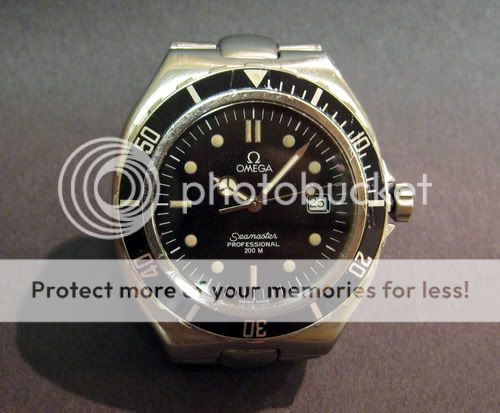
Sapphire crystal
Omega symbol and name under the 12:00 index.
Luminous dots at 1, 2, 4, 5, 7, 8, 10 and 11
Luminous single index at 6 and 9 with a lumed double index at 12.
Date window at 3
Square tooth notched 60 Click uni-directional bezel marked with numbers 10, 20, 30, 40 and 50, large hash marks at 5, 15, 25, 35, 45, and 55 and a triangle with lumed pip at 60

200Mwater resistance
Screw down crown and case back
Integrated Omega 1455 bracelet
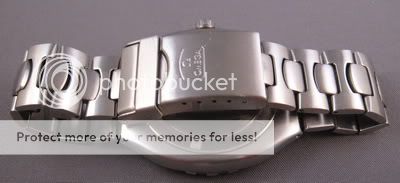
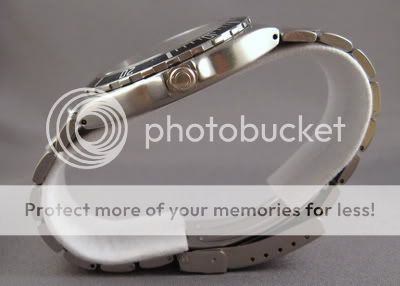
Finishes
The SEAMASTER 200 was available in three finishes on the case, Stainless, Stainless / 18K black dial or Stainless / 18K with Champagne dial. The Stainless / 18K versions also came with the option of a solid stainless steel bracelet or a stainless steel bracelet with inlaid gold links. The pictures below show only Color options and not sizes.
Also included is the price in swiss francs (CHF) and year of price (of those I could find).
Stainless steel,
Full size Quartz Ref ST 396.1041, CHF 800 (1992) CHF 1100 (1994)
Mid size Quartz Ref ST 396.1042, CHF 1000 (1995)
Full size Auto Ref ST 398.1041, CHF 910 (1991)
Mid size Auto Ref ST 398.1042

Stainless / 18K gold with gold inlaid bracelet and black face. I found the 18K versions to be especially interesting because the bezel is not gold plated but rather solid 18K gold.
Full size Quartz Ref DB 396.1041, CHF 2250 (1994), CHF 1875 (1992)
Mid size Quartz Ref DB 396.1042, CHF 2050 (1995)
Full size Auto Ref DB 398.1041, CHF 2025 (1991)
Mid size Auto Ref DB 398.1042
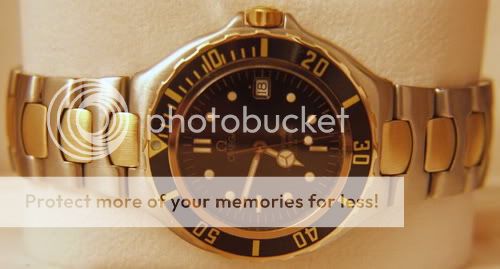
Photo by PPaulusz
Stainless / 18K gold with champagne face
Ref # same as with black face but added ref Black .300, Champagne .200
Full size Quartz Ref DB 396.1041, CHF 2250 (1994), CHF 1875 (1992)
Mid size Quartz Ref DB 396.1042, CHF 2050 (1995)
Full size Auto Ref DB 398.1041, CHF 2025 (1991)
Mid size Auto Ref DB 398.1042

Photo by HughWright
Stainless / 18K with Steel Bracelet
Full size Quartz Ref DR 396.1041, CHF 1150 (1994), CHF 1875 (1992)
Mid size Quartz Ref DR 396.1042, CHF 1350 (1995)
Full size Auto Ref DR 398.1041, CHF 1350 (1991)
Mid size Auto Ref DR 398.1042

Photo by Reto Castellazzi
HANDS
The SEAMASTER 200 was initially produced with a Mercedes hand set.
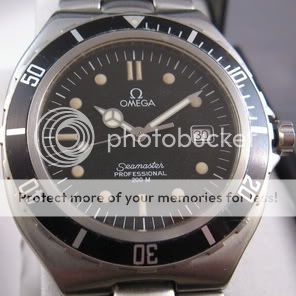
These were eventually replaced with the Omega sword hands.
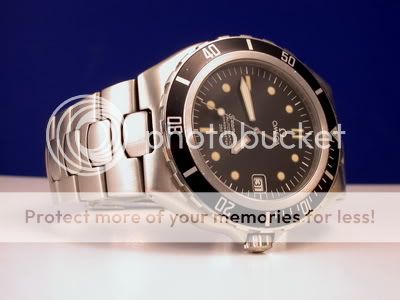
photo by d2dw
Movements
At the time of the SEAMASTER 200 introduction, Omega was moving away from completely in house movements and moving to ETA movements. The SEAMASTER 200 was available in both quartz and automatic movements. According to accounts the automatic version was produced in much smaller numbers compared to the quartz versions making it rather scarce. I believe however that the 1441 High-end quartz movement was the most rare, being introduced in 1987/88 and replaced late in 1988 by the 1438 quartz movement thus being in production for one year or less.
Automatic
The automatics were powered by the Omega 1111 (ETA 2892-2) movement and marked with "AUTOMATIC Chronometer". This 21 jewel movement features quickset date, sweep second 44 hour power reserve and hacks. (Sorry no pics but feel free to donate one if you like)
Quartz
The quartz versions were marked with "PROFESSIONAL"
Omega 1441 (ETA 255.561)
The quartz version started off with the Omega 1441 movement in late 1987 and by the end of 1988 and was fitted with the Omega 1438 movement. The 1441 movement stands out as it is a Thermo-compensated high-end quartz movement.
Collectors note: The 1441 is easily differentiated from the later 1438 (evenin small pics of the movement) by the two silver crystal units on the 1441 as opposed to the single crystal unit on the 1438.
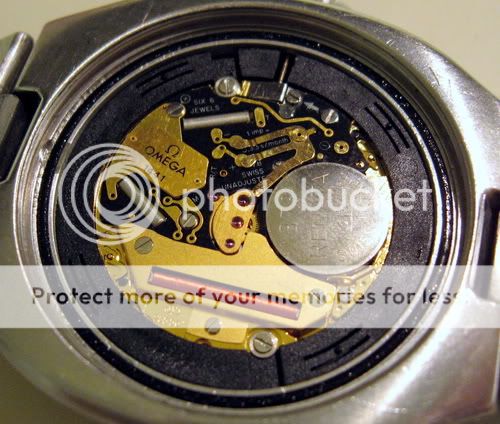
Here is a copy of the manual for the 1441
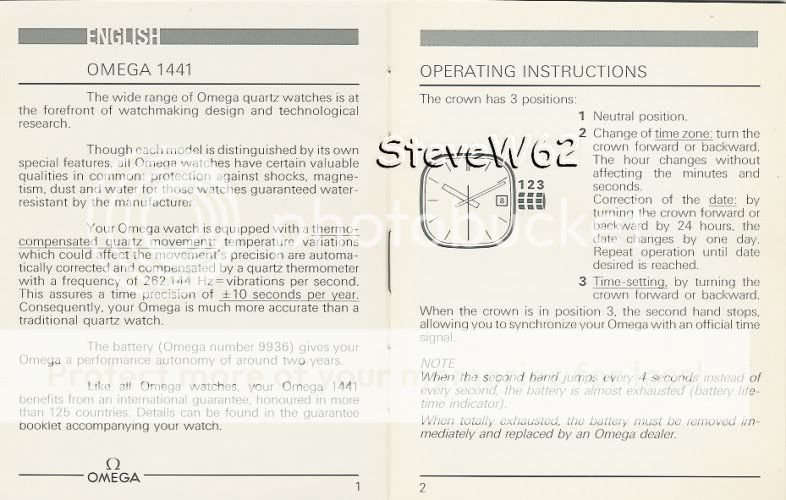
Photo by Steve Waddington
If that's too hard to read it says (in part)
This movement is Omega's second most accurate movement with the first being the Megaquartz 2400 one of, if not the most accurate movements in the world.
For further fine tuning the movement can be user regulated in increments of 0.33 seconds per month. (1 impulse = .33 sec/month)
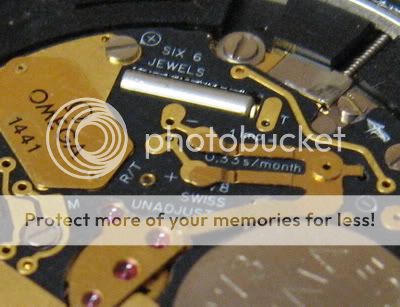
Omega 1438 (ETA 255.461)
By the end of 1988 the 1441 was replace by the 1438.
6 jewel quartz movement with date.

photo by Reto Castellazzi
Case sizes
The Seamaster 200 was available in a full size version (40 mm w/o crown) official size 8.85 x 38.5 x 43.5 and a midsize (38mm w/o crown) official size 8.7 x 36 x 41. There are some subtle differences in the two sized dials.
Now that we know the movements and the case sizes, let's have a look at how they can easily be differentiated just by looking at the dials.
The movement type can be determined by the dial either printed PROFESSIONAL (Quartz) or AUTOMATIC Chronometer (Auto), both with 200 M printed below. If the picture is too small to make out the print, the auto will have 4 lines of text on the bottom half and the quartz will have three lines of text.
The size can be determined by knowing the movement (auto vs quartz) and then looking at the relationship between the date window and the hash marks. On the Quartz full-size there is a gap between the date window and the hash marks, while on the mid-size the date window touches the hash marks. For the auto, the full-size date window touches the hash marks, while the mid size window obliterates the hash marks.

1st and 2nd Generation?
It has been said that the Pre Bond line has a 1st and 2nd generation. Some have suggested that the distinction is based on hand sets i.e. Mercedes vs Sword. I believe that the difference is in the crowns and the clasps.
The earlier models have a 6 lobed crown, and single fold over Divers clasp


While the later versions all seem to have a more circular ribbed crown and double fold over divers clasp.
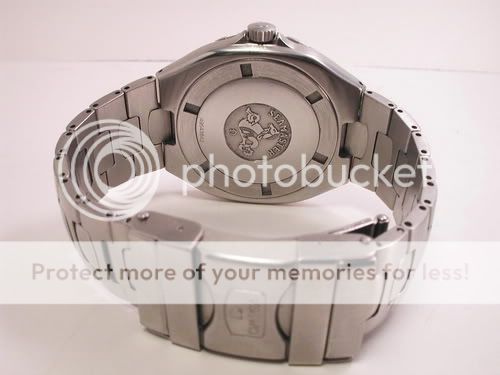
Photo by D2DW
Because the both handsets have been found on both crown/clasp styles, and the fact that the hands are easily changed, I hesitate to use them as a definer of the two generations. Since the crown/clasp combos exist in one combo in the beginning and a second combo towards the end, I find this to be the main distinction.
Case backs
Over the course of the SEAMASTER 200 line the case back underwent a few changes. In fact, the earliest case back style looks so different from what we are used to that over the years a few collectors have shied away from purchasing the model for fear of it being fake.
The earliest models came with a simple unadorned concave back with the Omega symbol, name and SEAMASTER simply stamped into the surface.
This is a 1987/88 2 piece quartz case back (notice the 6 lobed crown)
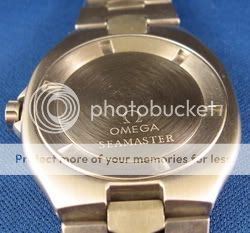
Here is a 1988 2 piece Auto case back (also a 6 lobed crown) The non concave back may be to make room for the thicker auto movement.
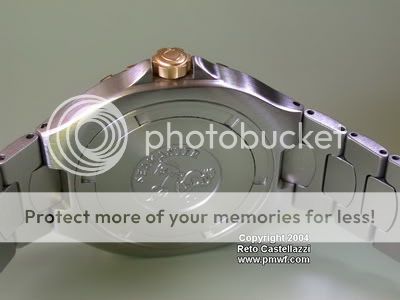
Photo by Reto Castellazi
Another 2 piece concave case back but notice the ribbed 2nd gen crown.
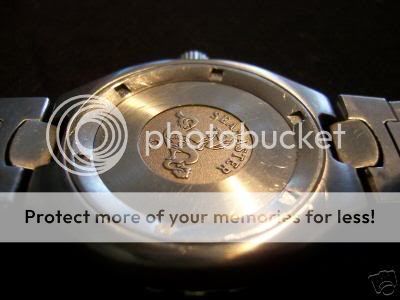
Photo by Raz44
Finally a late model 1 piece case back with ribbed 2nd gen crown.

Photo by Raz44
And finally the clasps.
As stated previously, the earlier clasps were a single fold over with foldout diver's extension.
Note the differences between the all stainless and stainless 18k versions.
Stainless with the logo stamped
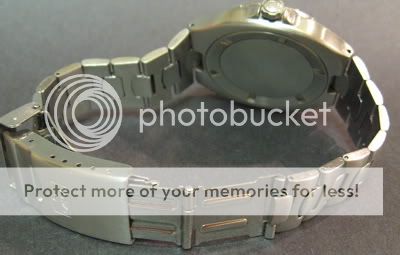
Stainless / 18k with stainless band with gold insert
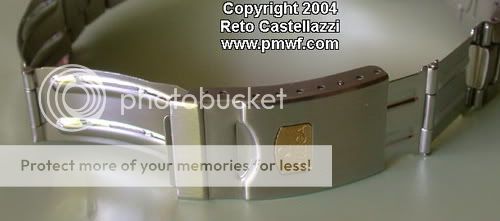
Photo Reto Castellazzi
A closer shot of the insert on a Stainless / 18k with gold inlaid stainless band
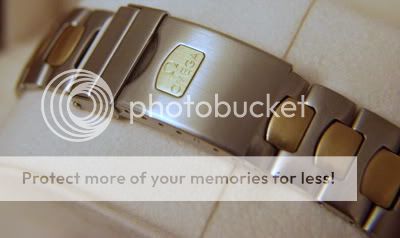
Photo by PPaulusz
Later versions went to a double fold over clasp

Photo by D2DW
That pretty much completes the review of the Omega Seamaster 200 Pre-Bond line. You have seen all the various parts that makeup the different versions. But we all know that a watch is more than the sum of its parts. So to finish off I would like to offer you an enticing bit of Seamaster 200 eye candy.
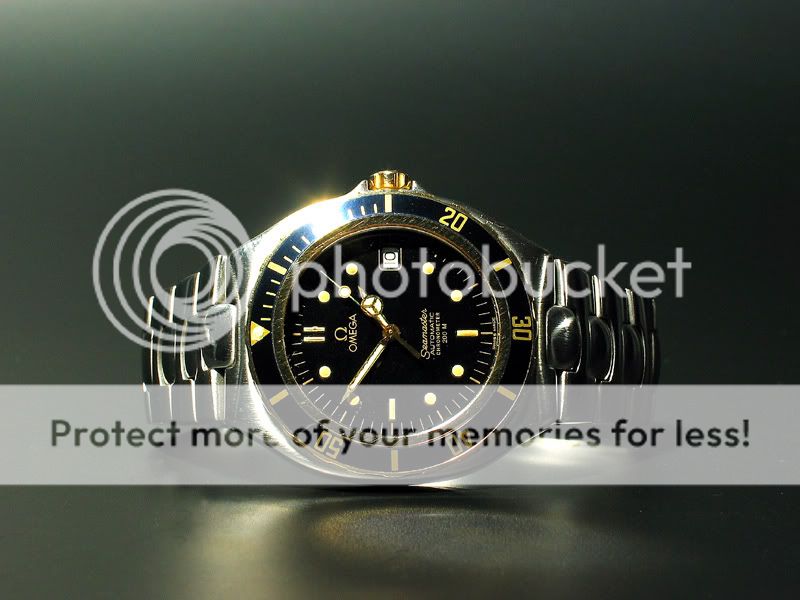
photo by Jaap
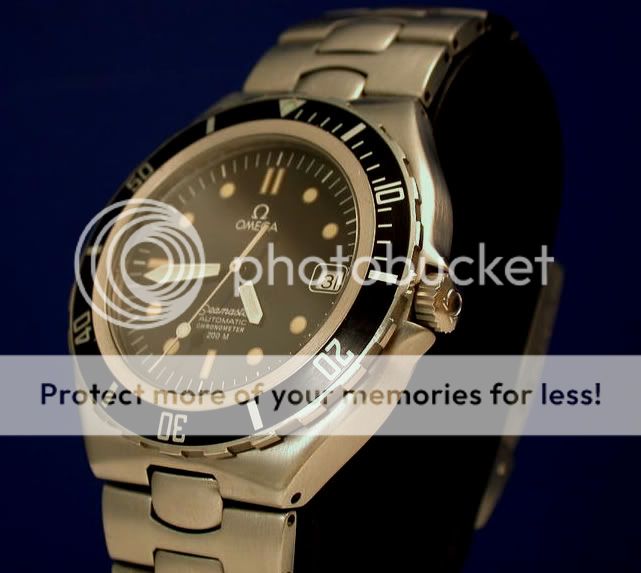
Photo by David Wrubel
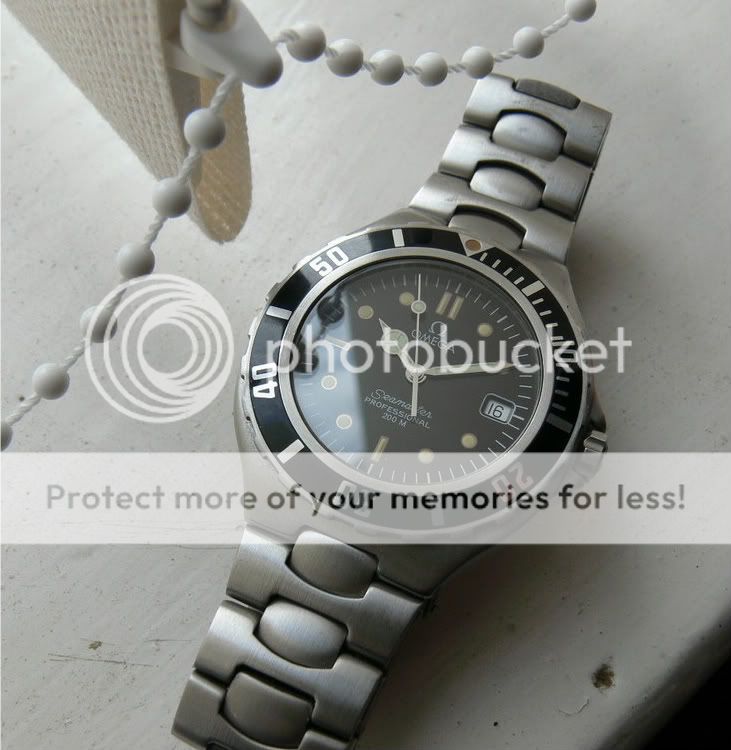
photo by Wis_Chronomaster
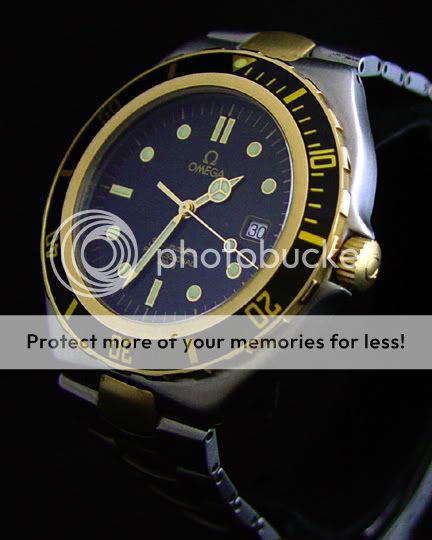
Photo by D2DW
What's this, a dive watch near the water?
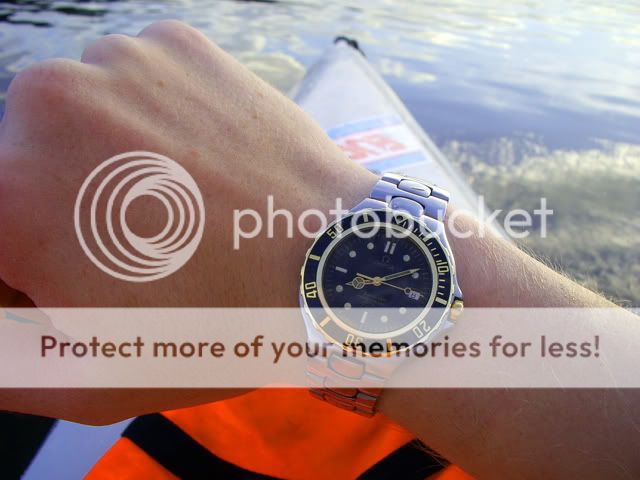
photo by y2keable
And finally (yes really this time) a wrist shot of the watch that started my quest.

Special thanks go out to the following WIS for use of their pictures and as a great reference source for the Seamaster200
PPaulUSZ
y2keable
David Wrubel
Hugh Wright
D2DW
Raz44
Wis_Chronomaster
Omega Vintage database
Reto Castellazzi http://www.pmwf.com/Watches/OmegaTable.htm
Falconxp http://www.falconxp.tweakdsl.nl/mainframe.html
Steve Waddington http://www.old-omegas.com/
A few parting words. I tried to make this review as complete as possible. Any omissions or mistakes are purely my fault. Thank you to all who responded to my "permission to use pics of your watch" PM's and emails. Since I only own one version of this watch, this review would not have been near as informative without all your cooperation. If I have used a picture of yours without proper credit given, I apologize. Just send me a note and corrections will be made. I certainly want to give credit where credit is due. Though the text may be a little dry, Believe it or not I typed up this review on a keyboard with a faulty spacebar. Man, I hate computers. (But I do love watches!)






























